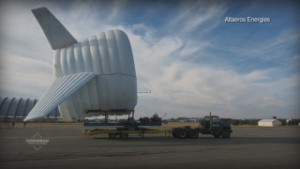The United Kingdom may seem an unlikely candidate to lead a renewable
energy revolution; it doesn't have much sun for solar power, it doesn't
have much space for wind power and it doesn't have giant coursing
rivers for hydro.
 The exciting future of wind energy
The exciting future of wind energy
It does, however, have
thousands of miles of coastline and a lowering and restless sea whose
tides ebb and flow with tremendous force.
Energy companies in
Scotland and Wales are seeing the potential from underwater turbines
which tap a constant and predictable source of energy, are invisible and
can produce as much electricity as a conventional wind turbine.
 The exciting future of wind energy
The exciting future of wind energy
If a test project in the
fast flowing marine waters of Pentland Firth in the far north of
Scotland goes well, submerged turbines could eventually power as many as
400,000 Scottish homes, according to the Scottish-government backed
scheme.
Predictable flow
"The demonstration array
at the moment is 6MW or four turbines. Hopefully this will be the
catalyst for further investment," MeyGen CEO Dan Pearson told CNN. "We
are looking to complete construction of that in 2016."
Sea water is 832 times
denser than air, which means the turbines can be smaller while producing
a similar amount of energy to a wind turbine. The force of these tides
also means the turbines can be placed closer together, taking up less
space on the sea bed than an equivalent wind farm on land.
Apart from being
invisible -- obviating a factor that has stalled many wind farm projects
on land -- the marine turbines have the great advantage of tapping an
energy source that does not rely on the weather.
Other renewables such as
wind, wave, solar and even hydroelectricity depend in large part on
seasonal and climatic features, tidal turbines, meanwhile, get two
regular tide changes a day.
"We can forecast over the next 100 years pretty accurately -- we know when the power's coming," he said.
Scrap metal as an anchor
The plan is for the
stands for the turbines to be lined up 525 feet (160m) apart and
weighted to the sea bed with scrap metal. With a depth of 130ft (40m),
Pearson says that vessels would have a clearance of about 8m, plenty, he
says, for the small craft that ply the four mile region.
"These are really cut
down versions of wind turbines, such that most of the electrical
equipment is onshore so that if something goes wrong, we can get a Land
Rover and drive to the substation rather than having to get a boat and
pick them up.
"That's one of the core advantages of this technology."
Other issues such as maintenance and corrosion have been solved, in large part, by using the advances in other technologies.
"It makes use of a large
knowledge base, for example the seals and solutions have been solved by
propeller technologies on ships, problems of corrosion are well known
from subsea structures like bridges or oil rigs.
There has been a lot of work done on how seals and whales interact with these turbines and they do get a bit curious
Dan Pearson
Dan Pearson
"What you're seeing is nothing brand new, it's just a lot of components coming together and I think that's the beauty of it."
Safe for sea life?
Concerns over the impact
on marine life were also raised during the planning process, but
Pearson said the simple fact is the turbines move so slowly -- at
between 12-18 RPM -- that experts believe most sea life would be able to
either ignore or get out of the way of the blades with ease.
"We've been working
closely with institutions such as Scottish Natural Heritage and the
Royal Society for the Protection of Birds because we have diving birds
in the area," Pearson said. "We have seals, we have whales, we have
dolphins -- it's beautiful up there."
He said undersea
monitors have been logging the wildlife in the region over the past five
years and that various groups now have a clear baseline of which
animals populate it.
"There has been a lot of
work done in other parts of the world on how seals and whales interact
with these turbines and they do actually get a bit curious.
"But these rotations of
the blades are quite slow in comparison with wind turbines and the
theory is that they can just get out of the way.
He said research had shown that most marine life avoids tidal surges when they are in full flow.
"I can imagine seals
dancing around them, but the only time they'll be playing around them is
when the flow is benign -- and that only lasts for about an hour and a
half and at that time the blades aren't rotating.
"We don't want to be blasé about it, but at the same time we have a high degree of confidence."
The immediate future of
the energy source, he said, was looking good, with leases around
Scotland showing the potential to produce 1.2GW -- more than twice the
energy produced by an average-sized nuclear power plant.
"The UK has a good
chance to develop and manufacture these turbines for world consumption
in a beautiful part of the world which currently has a low GDP," he
said.

No comments:
Post a Comment